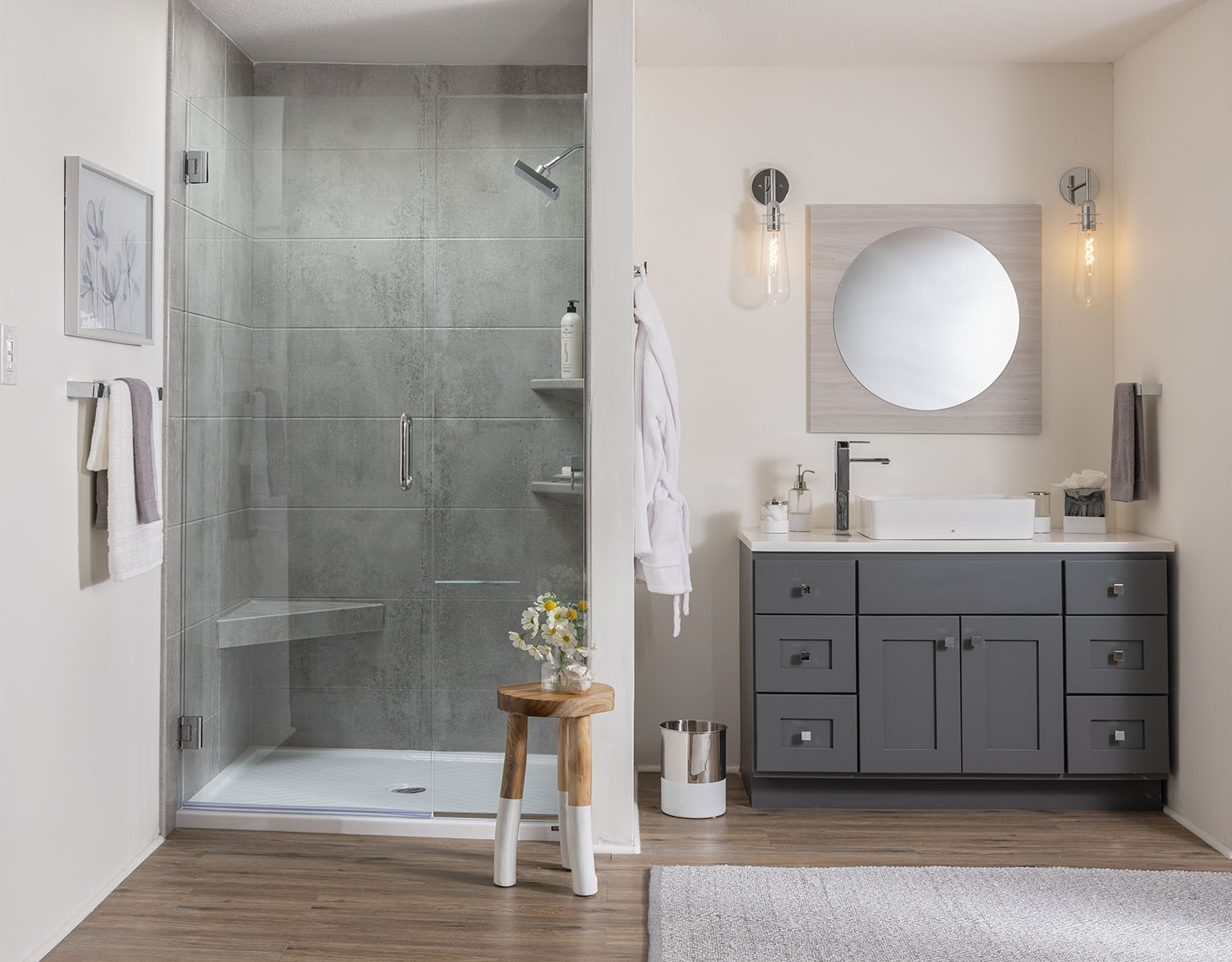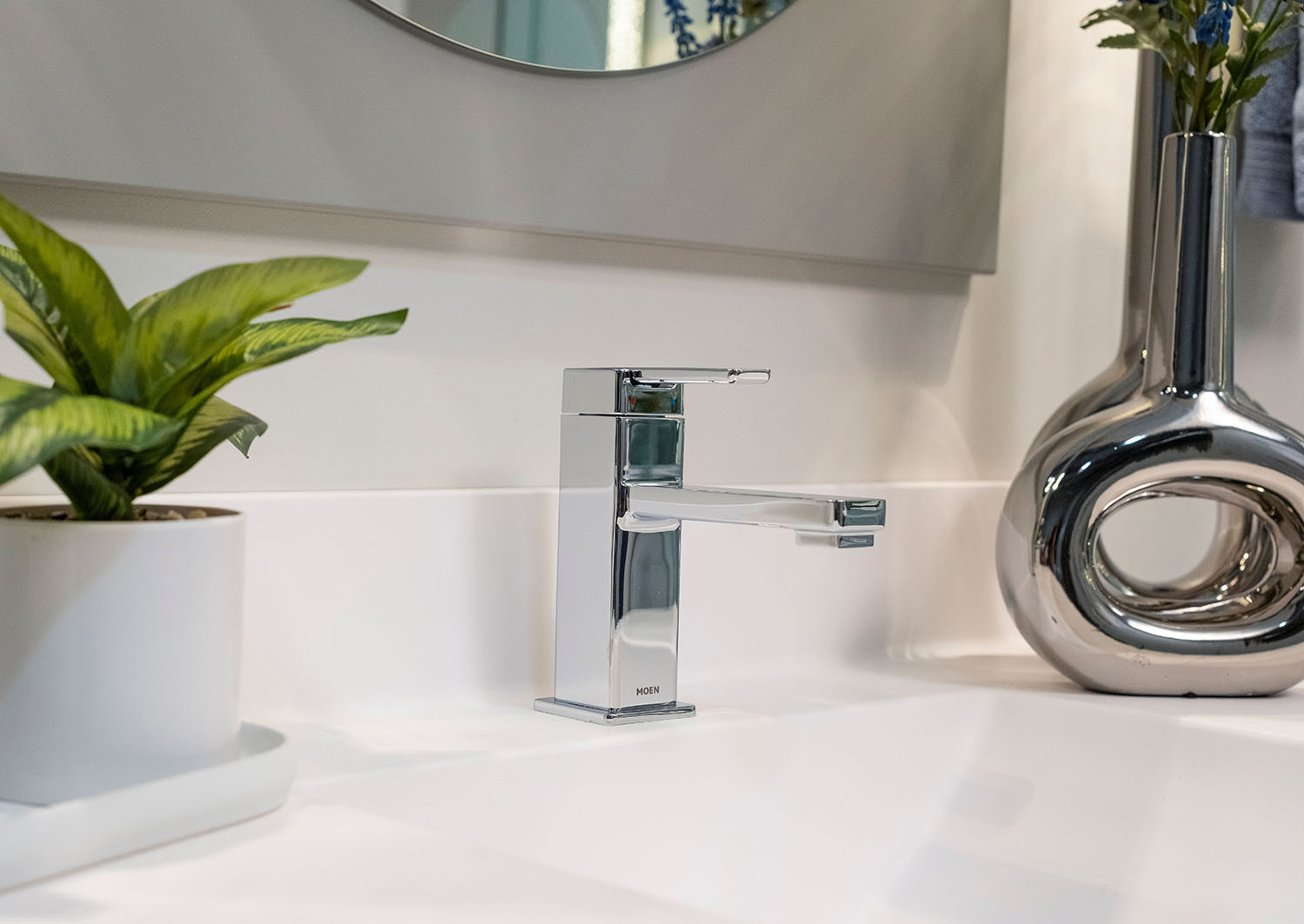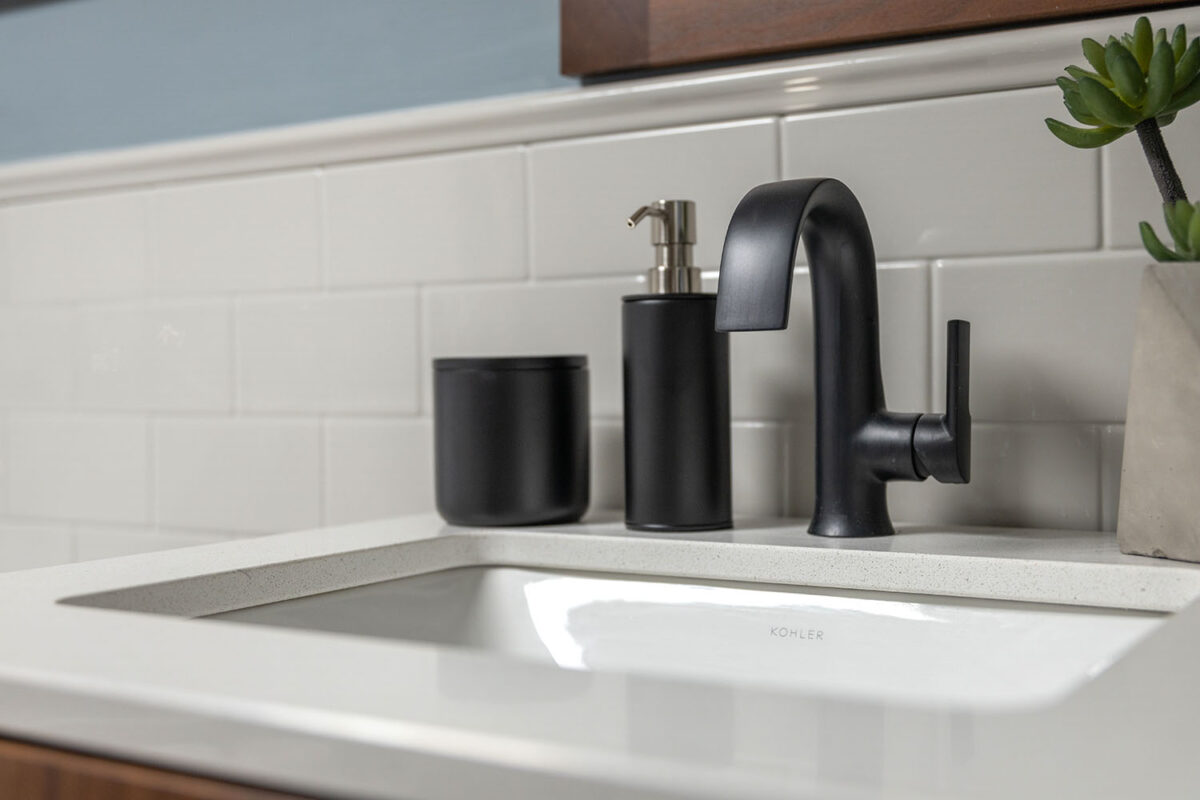Bathroom Countertop Materials & DIY Options
The first thing you see when walking into a bathroom is the vanity, including whatever is on the countertop. It is a focal point, certainly, but it is also an area of the bathroom that gets a lot of use. The materials used on the counter need to stand up to water, cleaning and daily wear and tear. To select the best bathroom countertop materials for your home, think about who will be using the bathroom (and how) as well as your style preferences. The best countertops for bathrooms balance both form and function.
In this guide, we will dive into the different bathroom countertops as well as options for refreshing your bathroom counters without a full remodel.
Natural Stone Countertops vs. Man-Made
Natural-looking stone is a perennial favorite in bathroom design. It can suit any aesthetic, from a formal look with white marble to a rustic bath featuring soapstone–and nearly everything in between. Whether naturally mined or engineered, there are dozens of options and hundreds of colors to choose from. Like any other material used in the bath, each has its advantages and disadvantages.
To help you sort through the details and find the best bathroom countertop material for your project, here are some of the most popular natural stone and man-made options.
Popular Natural Stone Countertop Materials
- Marble: When you think of an elegant bathroom, marble probably comes to mind. A beautiful material that can be all white or feature swirls of color, marble is a premium material and has been used in bathrooms for centuries. Its beauty does come at a price, however. Marble is one of the most expensive materials you can choose, and it can also be difficult to maintain. Softer and more porous than many other materials, marble needs to be carefully sealed when used in a bathroom, and care needs to be taken to avoid staining it. Something as simple as setting down a coffee cup or dribbling an oily lotion on the counter can result in a stain that is difficult to remove from a marble bathroom countertop.
- Granite is the most commonly used countertop material. One of the hardest natural stones, granite bathroom countertops are extremely scratch and chip resistant. However, though it is not as porous as marble, granite still requires sealing to prevent staining. Available in a wide variety of colors and patterns, each granite slab is unique and may not look exactly like the samples you used when making your choice.
- Travertine is a popular countertop material that offers a natural stone look at a price point that is lower than marble. Durable and stain-resistant, light-colored travertine is commonly used in bathroom design. There is one major drawback to travertine, however. A form of limestone, travertine is highly reactive to acids. Common household substances like lemon juice and vinegar–both often used as natural cleaners–can react with travertine and damage the counter surface. Travertine must be sealed and maintained with care to ensure its good looks.
- Quartzite is another incredibly hard and durable option for bathroom counters that is resistant to scratching, cracking and heat. Available in many colors and patterns, including some that are similar to marble, quartzite can be a fantastic option. Like many other kinds of natural stone, however, it should be sealed to maintain its good looks and guard against stains.
- Soapstone is an interesting material with unique advantages over other types of natural stone. A dark grey, non-porous stone, soapstone is stain resistant and will shrug off lotions, perfumes, shampoos and other common substances that can stain other kinds of natural stone. Softer than other natural stones, soapstone is not polished to a high shine. Instead, it develops a natural patina, an effect that can be enhanced by oiling the stone.
If you love the looks of natural stone but want to avoid the maintenance and cost of stone counters, there are a variety of man-made materials that are beautiful, easy to care for, and less expensive to install. Some of the most popular options include:
- Quartz countertops look (and sound) like they are made of natural stone, but quartz is a man-made material. Engineered primarily from quartz dust with some added resin, quartz is a top-notch option for the bathroom. Non-porous, chip and scratch resistant, durable and beautiful, quarts bathroom countertops are designed to last and look great. You can find marble lookalikes complete with irregular veining, plain solid colors and a wide variety of patterns made of quartz.
- Faux Granite countertops blend the best of both worlds, providing the durability and beautiful looks of granite with the consistency and versatility offered by engineered materials. Designed to be easier to care for, faux granite is non-porous and does not readily stain.
- Cultured Marble is a terrific way to get the look of marble but in a durable, versatile and stain-resistant material. Made of a blend of marble dust and resin, with added pigments to create a wide range of available colors and patterns, cultured marble is non-porous, eliminating the need for frequent sealing and making it easy to clean.
- Solid Surface Countertops are economical and available in various colors and patterns. Made from a single solid piece of material, these manufactured countertops come in a variety of looks, including wood, stone, quartz, granite and marble. Solid surface vanities and countertops can also be repaired if scratched–an important advantage over other materials.
Ultimately, the choice between using natural and man-made stone for a bathroom countertop will come down to personal preferences, how the bathroom will be used and your budget, whether you are looking for a single or double sink bathroom countertop. If you value uniqueness and are willing to invest in maintenance for a more luxurious look, natural stone might be the way to go. On the other hand, if ease of care, consistency in appearance, and resistance to stains and bacteria are important to you, manufactured materials could be a better fit. Both options can provide beauty and durability, so consider which factors are most important to you in making your decision as you remodel your bathroom.

Best Bathrooms Sink Countertop Colors
Once you have selected the material for your project, the next step is choosing the color for your bathroom vanity countertops. Most people stick to a neutral color for the bathroom countertop and incorporate brighter colors on the cabinetry and walls. However, just because the most popular choices are neutral tones does not mean that the selections are limited. As you will see, there are plenty of options when it comes to countertop colors.
White and Bright: Plain shades of white, eggshell and cream are timeless and popular choices. Clean white bathroom counters are a classic choice that looks great with either matching white cabinetry or as a point of contrast with a beautiful wood or brightly colored vanity. More muted shades of cream and eggshell offer similar impact but with a softer look.
Dark and Moody: Darker, moodier bathrooms are on trend, and charcoal grey or black bathroom countertops are popular choices that add drama to the space and are easy to clean. Deeply colored granites with gleaming flecks of mica, charcoal-colored marbles with thin streaks of white and gleaming black counters and sinks are all great options for a moody, high-drama look.
Natural-Looking Stone: Natural-looking stone in shades ranging from pale parchment and cream shades to deep beige, rich brown and bright terra cotta work for various aesthetics and styles, from serene spa looks to rustic designs. Look for man-made options if budget constraints or maintenance are of concern.
As you think through your choices, be sure to talk to your designer or contractor about the availability of materials, especially when considering natural materials. Many types of stone used in homes today are imported from overseas, and deliveries can take months. Taking supply chain considerations into account can make or break the timing of your project. Here at Re-Bath, we have developed a remodeling process in coordination with our suppliers that allows us to complete a full remodel within days, not weeks.
How To Refresh Your Bathroom Countertop
There are plenty of choices when it comes to choosing a beautiful new countertop to complement your bathroom. But what do you do if you do not have the budget to remodel, or even replace the countertop? Good news–your funds may be limited, but your choices are not! There are a lot of ways you can refresh a dingy vanity top or old counter that you cannot stand to look at one minute longer.
Painting: One of the easiest ways to refresh your bathroom countertop is to paint it. You can paint over most surfaces, including laminate, wood, or even tile countertops. For the most durable results, use a two-part epoxy paint that has been formulated for bathroom surfaces. Follow the directions, taking care to thoroughly sand the surface to be painted, which will help the epoxy adhere and give you the longest-lasting results.
You can also use good quality oil-based or enamel paint. While they will not last as long as epoxy paint, they are easy to apply, and equally easy to refresh from time to time simply by applying another coat of paint as needed. As with epoxy, you will need to sand the surface you are painting first, and you will also need to apply a primer and let it dry completely before painting on your color of choice. Finish the job by applying a topcoat designed for use on countertops.
Countertop Refinishing Kits: If you would prefer a stone look rather than solid color, a countertop refinishing kit might be a viable choice. Inexpensive and designed to create a durable surface that mimics the look of stone, refinishing kits are available in a broad spectrum of colors and are specifically designed for use on countertops. These kits often include everything you need to clean, prepare, and refinish your countertop, including coatings that mimic stone or other materials. Most kits require multiple steps, including priming the surface before applying the desired color and then sealing the surface with a topcoat to complete the look and ensure maximum durability.
Laminate Overlay: A laminate overlay is a fast and inexpensive way to refresh your countertop, and if properly installed, can be more durable than paint. Available at home improvement stores, laminate sheets are available in a wide variety of patterns and colors. Follow the directions for installation, which will require you to cut the laminate sheets to size, prepare the surface, and using some specialized tools such as a trim router and scoring knife.
“Peel & Stick” Self-Adhesive Vinyl: Peel and stick countertop rolls are made of self-adhesive vinyl and are an extremely budget-friendly option for a quick countertop refresh. Available in countless patterns and finishes, you can find options that look like wood, marble, granite, and more. They are easy to apply but may not be as durable as other options.
Each of these options has its own set of pros and cons, including differences in cost, durability, and the level of skill required. It is important to consider how your countertop is used and the level of maintenance you are willing to perform before deciding on a method. Also, preparation work, such as cleaning and sanding, is crucial for ensuring the longevity of your new countertop surface.

Bathroom Countertop Storage
Speaking of quick ways to improve bathroom countertop looks and function, it is worth taking a minute to think about maximizing the space on your bathroom counter with different storage options. Storage always seems a little scarce in the bathroom, but choosing the right vanity, countertop organizer or even a cabinet that sits on the counter can create the needed space for bathroom necessities. Here are some ideas to consider.
- Freestanding Countertop Cabinets or Shelves: If you have too many things and too little countertop space, freestanding countertop cabinets and shelving units designed to sit on your counter, either between the sinks on a double vanity, or in corner space, could be the solution you need. Perfect for smaller, lightweight items, they are a fast way to add storage and style to your bathroom.
- Bathroom Countertop Organizer: Another option to consider when you are looking for more storage are simple bathroom countertop organizers. Available in a wide variety of sizes and shapes, you can find organizers perfect for keeping small bottles and jars tidy or giving larger items like hairdryers and hot tools a home.
- Small Wall Shelves: Another good option for removing countertop clutter is a small shelf or two mounted on an unused wall in your bathroom. While not technically countertop storage, small shelves that coordinate with other elements in your bathroom can help you tidy up your counter and make room for either additional storage or some fresh decor, such as a plant or pretty tray.
It’s important to note that these do-it-yourself options for refreshing your bathroom countertops are quick fixes that won’t stand the test of time. Most will require touching up and all will last longer with gentle use.
The bathroom counter is a key player in your bathroom’s form and function. Beautiful materials can accentuate the bathroom’s style and create a focal point for the space. Selecting the right material requires some consideration. This is where consulting with a professional designer can be incredibly helpful–they are aware of the pros and cons of all materials. They will be able to make recommendations based on your style preferences as well as your family’s needs.
